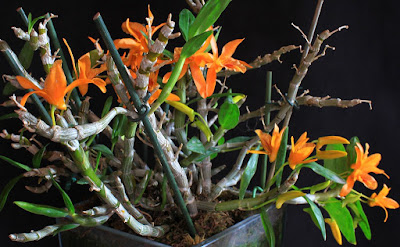Dendrobium Stardust is a hybrid whose parents are Dendrobium unicum and Dendrobium Ukon. This hybrid was created by N.Asai and was registered in 1986.
Dendrobium Stardust is a hybrid whose parents are Dendrobium unicum and Dendrobium Ukon. This hybrid was created by N.Asai and was registered in 1986.
IDENTIFY DENDROBIUM STARDUST ORCHID PLANT
Dendrobium Stardust is an epiphyte with thin and long, divided into segments, grow quite tightly to each other, reach 50 cm in length, and not more than 1.5-2 cm in width, pseudobulbs that often have a reddish tint, hang down to a greater extent than they grow straight up. The length of a pseudobulb depends largely on the intensity of illumination; the larger the sun, the shorter they are. The leaves are lanceolate, 7.5-8 cm long and 3-3.5 cm wide, keep no more than 2-3 years.
This hybrid blooms the most on the period from October to May. Peduncles appear from internodes on the side opposite to the leaf. One peduncle has from 1 to 5 flowers. The flowers are pale yellow to red-orange with darker (often brown) veins on the lip, about 6 cm in diameter. Duration of flowering about 4-5 weeks.
DENDROBIUM STARDUST ORCHID PLANT CARE AND CULTURE
Cultural information should only be used as a guide, and should be to be adapted to suit you. Your physical location; where you grow your plants, how much time you have to devote to their care, and many other factors, will need to be taken into account. Only then can you decide on the cultural methods that best suit you and your plants.
Light:
Dendrobium Stardust loves the bright sun without access to direct sunlight, so during the hot midday sun on the windows of the southern orientation and the hot evening sun on the western windows you should put the orchid behind a curtain (for example, on a table near the window) or in the shade of other plants. Otherwise, pseudobulbs and orchid leaves will get an ugly yellow-green shade. However, there is nothing terrible in it, on the general well-being of the plant this does not affect in any way. The more intense the lighting, the shorter the pseudobulbs of the orchid grow.
Temperature:
This hybrid belongs to the mixed temperature regime, and throughout the year it is recommended to keep the orchid under the following temperature conditions: Summer temperature at not above 32 °C; Winter temperature at 5-18 ° C. For successful cultivation at home, it is necessary that the night temperature of the content should always be 4-6 ° C lower than the daily one.
Humidity:
This orchid does not need the extremely high humidity of the air, and its rate can vary from 40 to 60%. Too dry air adversely affects the overall development of the plant - its growth is inhibited, and the leaves turn yellow and fall off prematurely. The higher temperature, the higher the humidity should be, and the higher the humidity, the more often and longer it is necessary to ventilate the room where orchids are contained, otherwise leaves of various kinds of fungal diseases.
Substrate, growing media and repotting:
Dendrobium Stardust is mainly grown only in the substrate in small narrow (often suspended) pots. To give the plant greater stability, it is advisable to use massive clay pots, since the pseudobulbs can grow very long and roll over to the side, turning the pot over. This hybrid does not have any particular preferences regarding the substrate and grows well in any ready-made shop mix with a high content of peat and sphagnum moss.
They does not need frequent transplants, therefore, it is desirable to transplant only in cases of strongly compaction of the substrate, with its critically high or low pH or when the plant grows strongly and the pot becomes cramped pseudobulbs begin to hang from the sides of the pot. The best time for transplanting is the spring period, when new orchid sprouts reach a size of 5 cm and begin to grow their own roots.
Watering:
During the period of new growth, Dendrobium Stardust needs frequent and abundant watering. Excess water during irrigation should flow freely from the pot, since stagnation of water both inside the pot and in its pan can very quickly lead to rotting of the roots and the lower part of the plant. The substrate between waterings should dry well. In other words, watering is needed only when the substrate is completely dry.
Fertilizer:
During the period of growth, this hybrid is fertilized once every 2-3 weeks in the usual concentration of fertilizer indicated on the package. In addition to root dressing, it is also recommended to produce foliar when the outer part of the plant is sprayed with very diluted fertilizer. It is best to feed the orchid, alternating between these two methods.
Rest period:
Dendrobium Stardust needs a well-defined rest period to stimulate flowering. It begins during the period of maturation of new pseudobulbs (that is, when a new young sprout finishes its growth, its top is rounded and only one fully expanded leaf remains on it and is expressed in the fact that the orchid is slightly drier and colder than usual, and do not fertilize. The general temperature of the content should be no higher than 16-18 ° C during the day and about 10 ° C at night. Watering orchids is best to stop completely or replace with a light spraying of the substrate and perform this procedure no more than once a month. With the advent of flower stalks the rest period ends: the total temperature of the content rises, and the watering of the orchid is resumed in the usual amount.

















COMMENTS